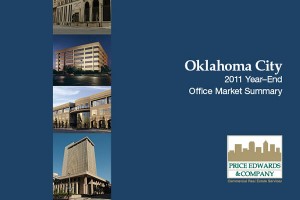
Despite a still sluggish national economy, Oklahoma City’s office market continued the positive growth that began in the second half of 2010. During the year, the Oklahoma City office market absorbed nearly 200,000 square feet of previously vacant space. The market’s overall vacancy rate decreased from 17% to 16.4%.
The Northwest submarket continues to lead the recovery in the suburban markets. That sector absorbed nearly 80,000 square feet and saw its vacancy rate decline from 11.6% to 9.9%. Class A buildings in the Northwest submarket have dramatically improved over the past two years, dropping from 24% to only 8.9% vacant. We fully expect that success to continue in 2012 and to trickle down into the other classifications and suburban submarkets.
It should be noted that in addition to general growth within the Northwest submarket, both the North and Northwest submarkets have been and will continue to be very positively impacted by Chesapeake Energy’s acquisition of approximately 800,000 square feet of multi-tenant buildings during 2011. While some of these buildings will remain multi-tenant offerings with Chesapeake occupying space alongside others, some will eventually be totally occupied by the energy giant as other tenants’ leases are allowed to expire. These acquisitions thus have the twofold impact of taking vacant space off the market at the buildings it has acquired and eventually putting displaced tenants out into the market to fill other vacancies.
For the local market to perform as well as it did is very positive considering approximately 600,000 square feet of available space will hit the downtown market over the next year as Devon Energy begins occupying their headquarters building which is nearing completion. The Central Business District experienced a drop in its vacancy rate from 24.9% to 22.8% during 2011 as the submarket experienced positive absorption of over 110,000 square feet. The CBD will be tested during the next few years as it lives through the growing pains related to the construction of the Devon Tower and the reconstruction of many streets and sidewalks in the central core, but when the work is complete it will result in a very vibrant business environment with greatly improved accessibility, public spaces and on-street parking options.
Backfilling vacated Devon space will certainly be a challenge for downtown landlords, but it should also prove to be a golden opportunity to attract suburban users that are quite frankly running out of good options in the outlying markets. To be successful in those efforts, downtown landlords will need to overcome the lack of well located and economically priced parking solutions. Oklahoma City is very much a personal vehicle town with minimal usage of mass transit options, which further exacerbates the issue. Most downtown tenants pay between $2.50 to $4.50 per square foot for their employees to be able to park in a well located facility. Right now, the average Class A rental rate in the suburbs is approximately $2.80 more than similar offerings downtown. It will bear watching to see if the rental rate spread widens enough to attract suburban users to the city’s core or if the downtown improvements are enough to attract suburban tenants on their own merits. We think some combination of the two should lead to improved CBD occupancy.
Our firm remains optimistic about the prospects for the local office market, believing we are still in the early stages of a recovery. Barring any dramatic changes to the national and worldwide economies, Oklahoma City is well positioned for significant absorption of its existing inventory of office space.
You can download Price Edwards & Company's 2011 Year-End market summaries here.




